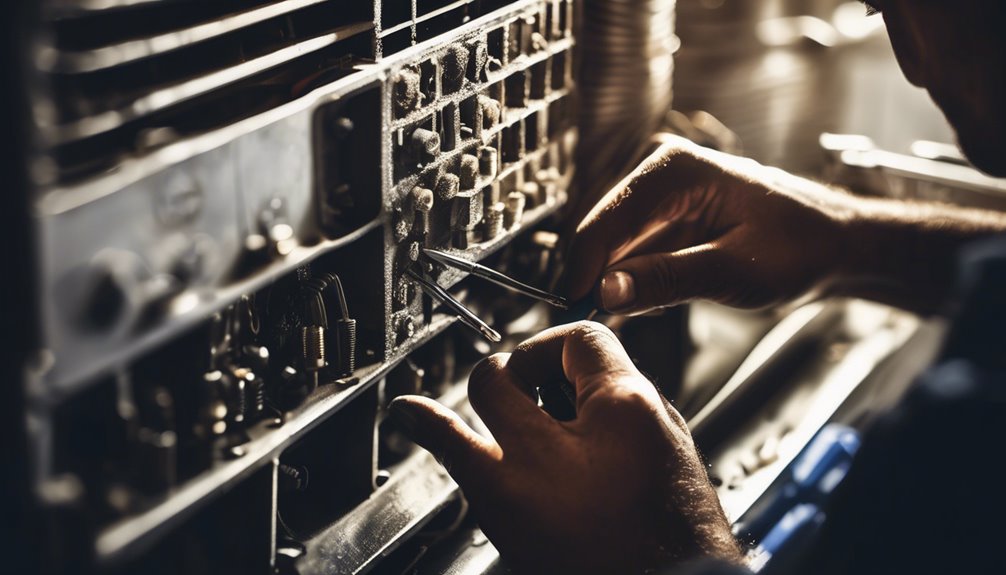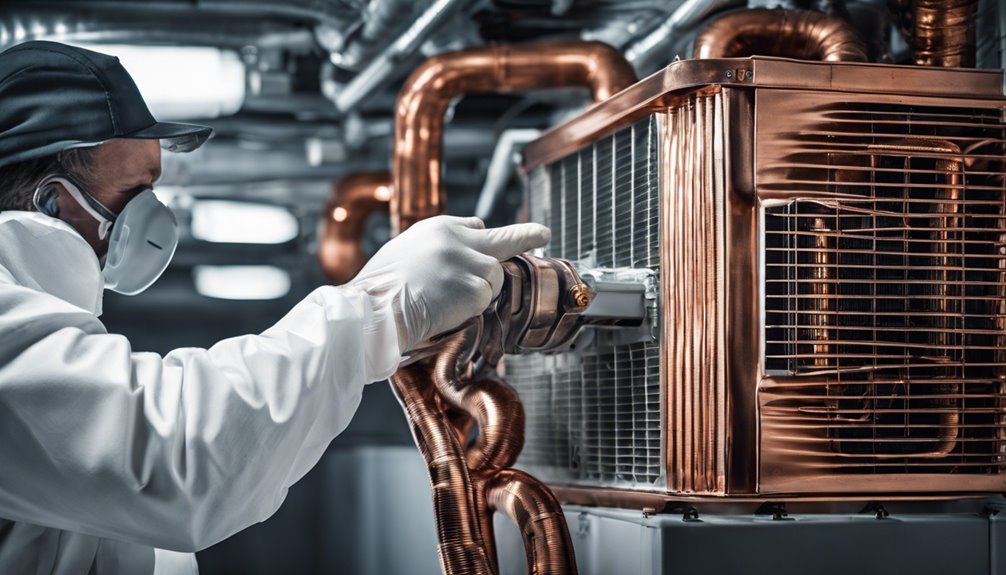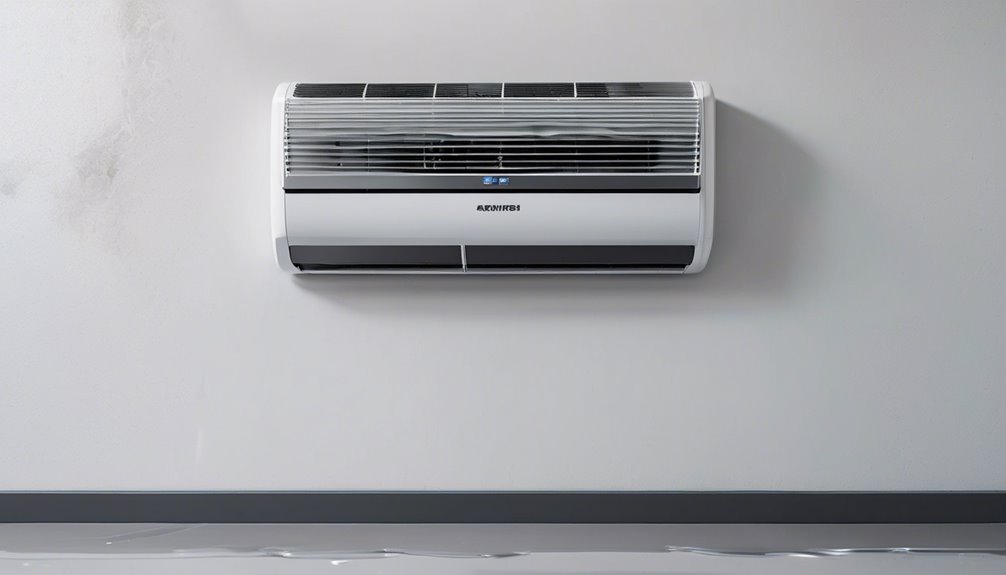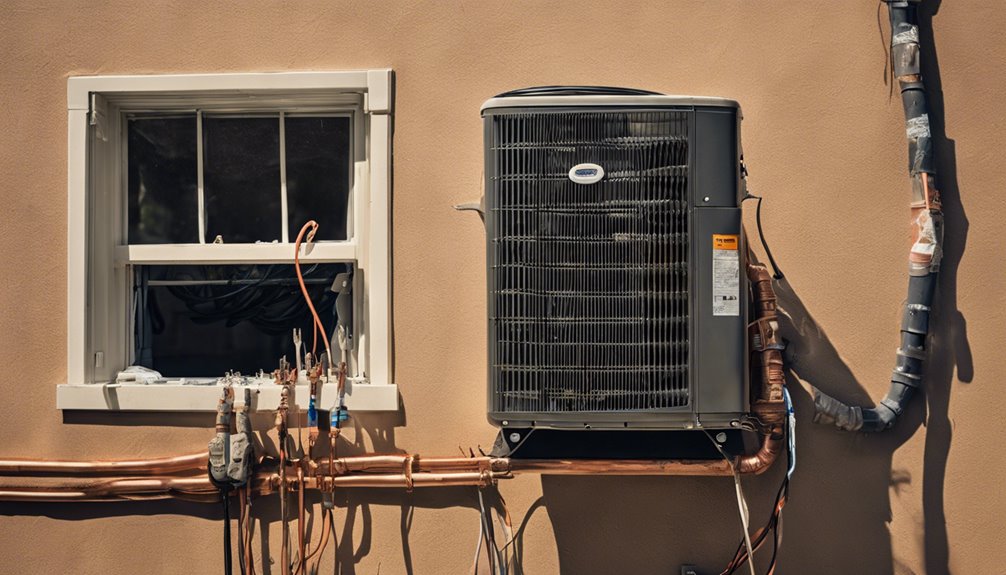By keeping your AC unit in top shape, you'll enjoy improved system efficiency, energy savings, and a reduced environmental impact. Regular maintenance prevents breakdowns, saving you money on costly repairs. Try your hand at DIY tasks like inspecting the exterior unit, cleaning condenser coils, and changing the air filter. But if you're not comfortable with more complex tasks like inspecting and sealing ductwork or fixing refrigerant leaks, it's best to call a pro. Dive deeper to learn more about maintaining your AC and keeping your home cool all summer long.
Key Takeaways
- Regular AC maintenance ensures efficient operation, energy savings, and reduced environmental impact.
- DIY tasks like inspecting exterior units, cleaning condenser coils, and changing air filters can be done to prevent breakdowns.
- Changing the AC air filter every one to three months is crucial for efficient airflow and preventing breakdowns.
- Cleaning the condenser coils and outdoor unit regularly is essential for the AC to run efficiently and effectively.
- Inspecting and sealing ductwork ensures optimal airflow, reduces energy consumption, and improves indoor air quality.
The Benefits of Regular AC Maintenance
Regular AC maintenance is crucial for ensuring your air conditioning unit runs efficiently and effectively throughout the hot summer months.
By keeping your AC well-maintained, you'll enjoy improved system efficiency, which means your unit will consume less energy to cool your home. This, in turn, leads to significant energy savings, reducing your utility bills and environmental impact.
Moreover, regular maintenance helps prevent breakdowns, saving you from costly repairs and the inconvenience of a non-functional AC during peak summer.
DIY AC Maintenance Tasks You Should Know
Your air conditioning unit requires routine upkeep to keep it running smoothly, and you can tackle some of these tasks on your own.
Start by inspecting the exterior unit for debris, leaves, or dirt that may be blocking airflow. Clean the condenser coils gently with a garden hose to improve efficiency.
For AC troubleshooting, check the circuit breaker or fuse box to ensure the unit hasn't tripped or blown a fuse.
You should also perform thermostat calibration by adjusting the temperature setting to ensure it's accurate. Check for any refrigerant leaks, and make sure all electrical connections are secure.
How to Change Your AC Air Filter
Every one to three months, you'll need to change your AC air filter to ensure efficient airflow and prevent damage to your unit.
Dirty filters can decrease airflow, increase energy bills, and even cause your AC to break down.
When selecting a new filter, consider the filter quality and choose one that fits your AC's specifications.
Turn off the power to your AC before starting the replacement process.
Locate the filter, usually found in a return air duct or near the AC unit.
Remove the old filter, taking note of the airflow direction, and discard it.
Install the new filter, ensuring it's securely fastened and airflow direction is correct.
Regular filter changes will keep your AC running smoothly and efficiently.
Cleaning the Condenser Coils and Outdoor Unit
You'll want to clean your condenser coils regularly to ensure your AC runs efficiently.
There are a few methods to do this, and it's essential to choose the right one for your system.
After cleaning the coils, take a closer look at your outdoor unit to ensure it's free from debris and functioning properly.
Coil Cleaning Methods
Dirty condenser coils and outdoor units can significantly reduce the efficiency of your air conditioning system, leading to increased energy bills and potential breakdowns. To avoid this, you need to clean the coils regularly. There are two common coil cleaning methods you can use: coil brush tools and vacuum methods.
| Method | Description |
|---|---|
| Coil Brush Tools | Use a soft-bristled brush or a specialized coil brush to gently remove dirt and debris from the coils. |
| Vacuum Methods | Use a vacuum cleaner with a gentle suction setting to remove dirt and debris from the coils. |
| Water Spray | Spray the coils with a garden hose to loosen dirt and debris, then use a brush or vacuum to clean. |
| Chemical Cleaning | Use a mild detergent and water to clean the coils, but be careful not to damage the fins. |
| Compressed Air | Use compressed air to blow out dirt and debris from the coils, but avoid using high pressure. |
Outdoor Unit Inspection
Now that you've learned about the different coil cleaning methods, it's time to put them into practice during an outdoor unit inspection.
Start by turning off the power to the unit to ensure your safety.
Next, inspect the outdoor unit's placement to ensure it's at least 3 feet away from any obstructions, allowing for proper airflow.
Check the unit's exterior for dirt, debris, or signs of damage.
Clean the condenser coils using the method you've chosen, making sure to gently remove any dirt or debris.
This will help restore outdoor functionality and improve airflow.
Remember to also inspect the unit's fan and motor for any signs of wear or damage.
Inspecting and Sealing Ductwork
You're likely aware that your ductwork is prone to leaks and gaps, which can significantly reduce your AC's efficiency and increase your energy bills.
When you inspect your ductwork, look for signs of damage, rust, or corrosion, as well as loose connections or joints.
Ductwork Leaks and Gaps
Leaks and gaps in your ductwork can be a significant source of energy loss and decreased system efficiency.
You'll want to inspect your ducts thoroughly to identify any areas where air is escaping. This is crucial because even small leaks can add up to big losses in energy and money.
- Ductwork pressurization tests can help you detect leaks and gaps, ensuring that your system is operating at optimal levels.
- Sealing these gaps will allow your AC to operate more efficiently, reducing energy consumption and your utility bills.
- Properly sealed ducts also improve airflow optimization, ensuring that cooled air reaches every corner of your home.
- By addressing ductwork leaks and gaps, you'll enjoy improved indoor air quality, reduced humidity, and a more comfortable living space.
Sealing and Insulation Methods
Once you've identified the leaks and gaps in your ductwork, it's time to seal and insulate them properly.
You'll need to choose the right materials for the job. Foam sealants are a popular choice for sealing small gaps and cracks. They're easy to apply and provide a flexible seal that can expand and contract with temperature changes.
For larger gaps, you can use spray foams that expand to fill the space. These materials will help prevent air leaks and reduce heat transfer, making your AC system more efficient.
Make sure to follow the manufacturer's instructions for application and drying times to ensure a proper seal. By sealing and insulating your ductwork, you'll be able to enjoy improved airflow and lower energy bills.
Identifying and Fixing Refrigerant Leaks
Refrigerant leaks can be one of the most common and costly issues affecting your air conditioning system's performance.
You mightn't even realize you have a leak until your energy bills start to skyrocket or your AC unit breaks down.
To identify leaks, you'll need to perform some leak detection.
- Use a refrigerant sniffer to detect the presence of refrigerant in the air
- Check for signs of oil or refrigerant around valves, fittings, and other connections
- Inspect your system's low-pressure side for signs of moisture or ice buildup
- Look for hissing sounds or bubbles in the refrigerant lines
When to Call a Professional for AC Tune-Ups
How often do you find yourself wondering if your AC is running efficiently, or if it's just a matter of time before it breaks down?
If you're unsure, it's time to call a professional for an AC tune-up. You shouldn't wait until your unit breaks down in the middle of a sweltering summer, leaving you stuck with Emergency calls and costly repairs.
Instead, schedule summer checks with a licensed technician to identify and fix potential issues before they become major problems. They'll inspect and clean your unit, check refrigerant levels, and ensure all components are working properly.
Frequently Asked Questions
Can I Perform AC Maintenance on My Own or Do I Need a Professional?
You can try tackling some tasks on your own, but be honest about your DIY capabilities – if you're unsure, it's better to acknowledge the professional necessity to avoid causing more harm than good, and potentially costly repairs down the line.
How Often Should I Clean My AC Condenser Coils?
You should clean your condenser coils every 2-4 months, depending on usage and outdoor conditions. Regular coil cleaning boosts efficiency and reduces energy bills. As part of outdoor unit maintenance, it's essential to remove dirt and debris to ensure optimal performance.
What Is the Average Cost of an AC Tune-Up?
You're wondering what you'll pay for a tune-up. On average, it'll cost you around $100-$200, but think of it as an investment – a tune-up can bring summer savings by reducing your cooling costs by up to 30%!
Can a Dirty Air Filter Cause My AC to Break Down?
You're probably aware that a dirty filter can choke your lungs, but did you know it can also suffocate your AC? A dirty air filter causes airflow restriction, reducing filter efficiency, which can lead to a breakdown, leaving you hot and helpless.
Will Regular Maintenance Help Reduce My Energy Bills?
You're curious about cutting energy costs! Regular maintenance will definitely help you achieve energy efficiency, leading to seasonal savings. By keeping your AC in top shape, you'll reduce energy consumption and enjoy lower bills all summer long.
Conclusion
By staying on top of AC maintenance, you'll avoid being stuck in a sweltering heatwave with a busted unit. Think of regular tune-ups like routine car maintenance – you wouldn't drive 10,000 miles without an oil change, would you? Same principle applies here. Neglecting your AC can lead to a 10-20% increase in energy bills and a shortened system lifespan. Stay cool, stay smart, and prioritize those routine check-ups!



